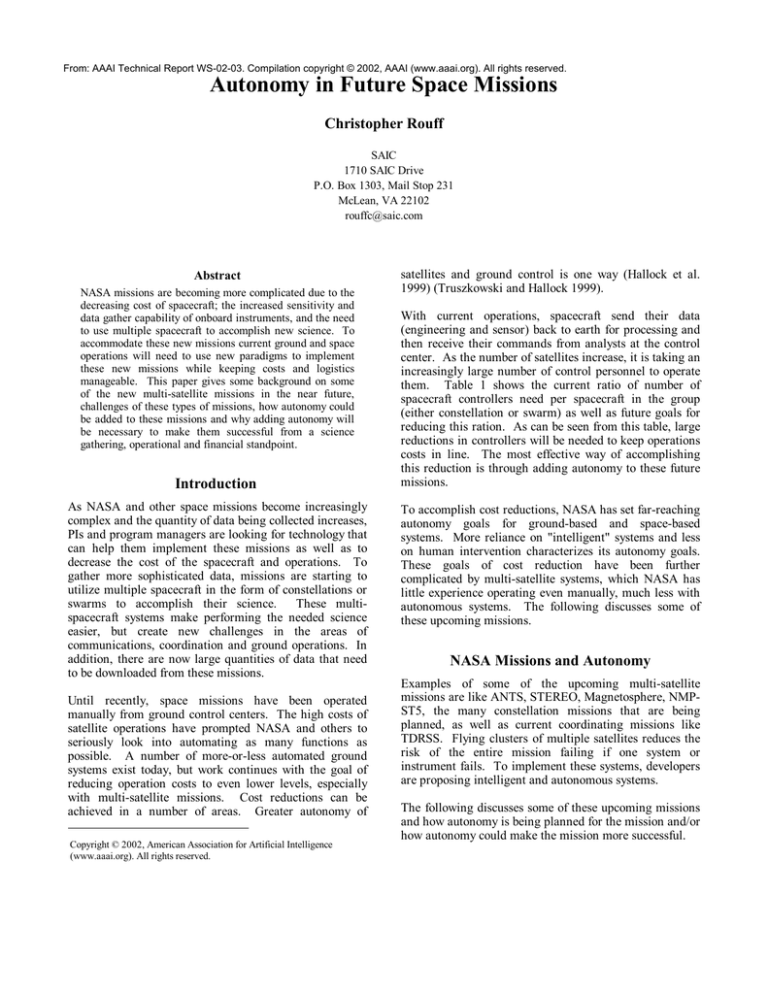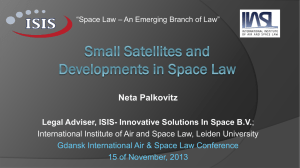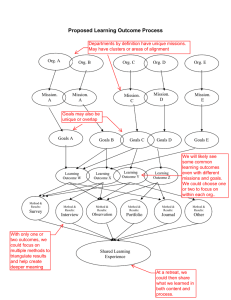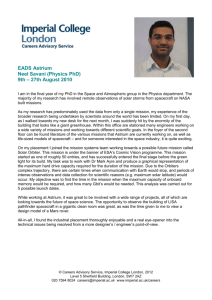
From: AAAI Technical Report WS-02-03. Compilation copyright © 2002, AAAI (www.aaai.org). All rights reserved.
Autonomy in Future Space Missions
Christopher Rouff
SAIC
1710 SAIC Drive
P.O. Box 1303, Mail Stop 231
McLean, VA 22102
rouffc@saic.com
Abstract
NASA missions are becoming more complicated due to the
decreasing cost of spacecraft; the increased sensitivity and
data gather capability of onboard instruments, and the need
to use multiple spacecraft to accomplish new science. To
accommodate these new missions current ground and space
operations will need to use new paradigms to implement
these new missions while keeping costs and logistics
manageable. This paper gives some background on some
of the new multi-satellite missions in the near future,
challenges of these types of missions, how autonomy could
be added to these missions and why adding autonomy will
be necessary to make them successful from a science
gathering, operational and financial standpoint.
Introduction
As NASA and other space missions become increasingly
complex and the quantity of data being collected increases,
PIs and program managers are looking for technology that
can help them implement these missions as well as to
decrease the cost of the spacecraft and operations. To
gather more sophisticated data, missions are starting to
utilize multiple spacecraft in the form of constellations or
swarms to accomplish their science.
These multispacecraft systems make performing the needed science
easier, but create new challenges in the areas of
communications, coordination and ground operations. In
addition, there are now large quantities of data that need
to be downloaded from these missions.
Until recently, space missions have been operated
manually from ground control centers. The high costs of
satellite operations have prompted NASA and others to
seriously look into automating as many functions as
possible. A number of more-or-less automated ground
systems exist today, but work continues with the goal of
reducing operation costs to even lower levels, especially
with multi-satellite missions. Cost reductions can be
achieved in a number of areas. Greater autonomy of
Copyright © 2002, American Association for Artificial Intelligence
(www.aaai.org). All rights reserved.
satellites and ground control is one way (Hallock et al.
1999) (Truszkowski and Hallock 1999).
With current operations, spacecraft send their data
(engineering and sensor) back to earth for processing and
then receive their commands from analysts at the control
center. As the number of satellites increase, it is taking an
increasingly large number of control personnel to operate
them. Table 1 shows the current ratio of number of
spacecraft controllers need per spacecraft in the group
(either constellation or swarm) as well as future goals for
reducing this ration. As can be seen from this table, large
reductions in controllers will be needed to keep operations
costs in line. The most effective way of accomplishing
this reduction is through adding autonomy to these future
missions.
To accomplish cost reductions, NASA has set far-reaching
autonomy goals for ground-based and space-based
systems. More reliance on "intelligent" systems and less
on human intervention characterizes its autonomy goals.
These goals of cost reduction have been further
complicated by multi-satellite systems, which NASA has
little experience operating even manually, much less with
autonomous systems. The following discusses some of
these upcoming missions.
NASA Missions and Autonomy
Examples of some of the upcoming multi-satellite
missions are like ANTS, STEREO, Magnetosphere, NMPST5, the many constellation missions that are being
planned, as well as current coordinating missions like
TDRSS. Flying clusters of multiple satellites reduces the
risk of the entire mission failing if one system or
instrument fails. To implement these systems, developers
are proposing intelligent and autonomous systems.
The following discusses some of these upcoming missions
and how autonomy is being planned for the mission and/or
how autonomy could make the mission more successful.
FY
Number of s/c
‘00
‘00
‘00
1 (e.g. MAP)
66 (e.g. Iridium)
48 (e.g.
GlobalStar)
3
50-100
‘03
‘09
Number of FTEs w/current
technology
4
200
100
Current
People:s/c
4:1
3:1
2:1
12
200-400
Goal
People:s/c
1:1
1:10
*GlobalStar and Iridium represent a simpler constellation concept than what is being proposed by
future NASA Science Mission.
Table 1: Ratio Goals for People Controlling Spacecraft
ANTS Mission
One of the new proposed missions that would use large
amounts of autonomous software is the ANTS
(Autonomous Nano-Technology Swarm) mission, shown
in Figure 1. The ANTS mission will have swarms of
autonomous satellites that will search for asteroids that
have specific characteristics.
There will be a number of satellites involved in the
mission, initially carried to the asteroid belt by a mother
ship. Some will have specialized instruments (called
workers) that can obtain specific types of data. Some will
be coordinators (called rulers) that have rules that decided
the types of asteroids and data the mission is interested in
and will coordinate the efforts of the workers. The third
types of satellites are called messengers and they
coordinate communications between the workers, rulers
and Earth. Each worker spacecraft will examine asteroids
they encounter and send messages back to a coordinator
that will then send other appropriate satellites with
specialized instruments to the asteroid to gather further
information. Testing such systems for errors, especially
since the satellites are heterogeneous and autonomous,
will be a difficult task.
NMP ST5
The New Millennium Program's (NMP) Space
Technology 5 (ST5), is shown in Figure 2.
Magnetometers onboard each of the satellites will measure
ANTS: Mission Concept 2020
2. Self propelled transit
Asteroid belt
1. Assembly & release
3. Long-Range Operations
Rulers
Asteroid(s)
Workers
Messengers
Workers
Workers
4. Swarm (Fly by) Operations
X-Ray Worker
Messenger
MAG Worker
IR Worker
Lagrange Point Habitat
Earth
6. A messenger carries
findings to Earth
when needed.
5. Repeat steps 3 and 4.
M. L. Rilee, EIT, S. A. Curtis, NASA/GSFC, 2001.
Figure 1: ANTS Mission Concept
Figure 2: New Millennium Program
the magnetosphere. Currently ST5 is slated for each of
the satellites to be commanded individually and
communicate directly to the ground. There will be one
week of “lights out” during which the nanosats will fly
“autonomously” with preprogrammed commands in a test
to determine if ground commanding is necessary. One
idea that has been explored is the idea of having proxy
agents on the ground that operate as if they are onboard
[Truszkowski and Rouff 2001]. Future nanosat missions
will fly with tens to a hundred spacecraft.
as much as ten billion tons of the Sun’s atmosphere can be
blown into interplanetary space, which can cause severe
magnetic storms on Earth. It will track CME-driven
disturbances from the Sun to Earth’s orbit and determine
3D structure and dynamics of coronal and interplanetary
plasmas and magnetic fields, among other things. It will
use two spacecraft with identical instruments (along with
ground-based instruments) that will provide a stereo
reconstruction of solar eruptions.
MMS Magnetosphere Multiscale
STEREO
The Solar-Terrestrial Relations Observatory (STEREO)
mission, Figure 3, will study the Sun’s coronal mass
ejections (CMEs) which are powerful eruptions in which
For the magnetosphere mission, each spacecraft will be
positioned so that it is located at one of the four points of a
pyramid. This arrangement will allow three-dimensional
structures to be described, for the first time, in both the
Figure 3: STEREO Mission studying the sun.
magnetosphere and solar wind. The four Cluster II
spacecraft will observe the response of Earth’s
magnetosphere to the ebb and flow of the solar wind.
Distances between the Cluster spacecraft will be adjusted
during the mission to study different regions and plasma
structures. Comparison of simultaneous measurements
from the different spacecraft will be combined to produce
a three-dimensional picture of plasma structures.
TDRS
The Tracking and Data Relay Satellite (TDRS) is involved
in relaying communications between satellites and the
ground.
There is no autonomous operations or
cooperative behavior with TDRS, but this is an application
were cooperative behavior could be added. In addition to
data relay, TDRS is in a position that could perhaps also
provide such things as computing services to missions so
that a central computing resource is available and each
spacecraft would not have to be launched with as much
computing power. This would provide a savings by
reducing the on onboard computing resources and the
corresponding weight to launch duplicate resources among
satellites.
•
•
•
GEC/Geospace Electrodynamic Connections is a
cluster of four satellites that will study the
ionosphere-thermosphere (2009),
LISA/Laser Interferometry Space Antenna will
consist of three spacecraft to study gravitational
waves (2010),
CON-X/Constellation X will provide teams of xray telescopes working in tandem to observe
distant objects (2010), and
MC/Magnetotail Constellation will constist of
50-100 nano-statellites that will study the
Earth’s magnetic and plasma flow fields (2011).
As can be seen from the above, NASA is planning on
relying heavily on cooperating multi-satellite systems to
perform new science that would be difficult or impossible
to do with single satellites.
Motivations for Autonomy
There are several ways autonomy can assist multi-satellite
systems in the above missions. The following are some of
the areas that autonomy could be used.
Communications Delays
Other Missions
Other multi-satellite missions that are being proposed or
planned include:
•
•
TWINS A and TWINS
stereoscopically image the
(2004),
B that will
magnetosphere
One area that has been realized where autonomous
software is needed is when communications can take more
than a few minutes between the spacecraft and the ground.
When communications is lengthened, the risk of losing
data or the spacecraft increases because monitoring the
spacecraft in real-time (or near real-time) is now longer
possible. The mission is flown more from a historic basis,
Figure 4: Tracking and Data Relay Satellite (TDRS)
Figure 5: Magnetosphere
and the operator needs to stay ahead of the mission by
visualizing what is happening and confirming it with
returned data. Science of opportunity is usually not
possible on missions with large communications lead
times. This type of science is usually impossible or not
practical because the science can be gone once the data is
transmitted back to Earth, analyzed and then satellite
instructions transmitted back. PIs are now looking at
autonomy or semi-autonomy to take advantage of science
of opportunity. Also, for spacecraft health and safety, the
large lead time in communications can also mean that a
spacecraft can be in jeopardy (such as when flying close to
an asteroid in ANTS), and without quick response, a
spacecraft could be lost.
Number of Spacecraft
For missions that are planning to use constellations of
satellites or swarms of satellites (or other vehicles),
autonomous software is being planned for controlling
them. The more spacecraft, the more people will be
needed to control them, and therefore higher operations
costs. It is being noticed that autonomous software is the
only way to control a large number of vehicles without
having to have huge computing resources on the ground,
and corresponding large communications systems onboard
the vehicle to transmit the large amount of data these
vehicles will collect, which will be needed to compute the
coordination between them.
Interaction of Spacecraft
Spacecraft that interact with each, either in the form of
formation flying or performing science, also have the
problem of having to download large amounts of data for
coordination purposes. They will also have large state
spaces for trying to keep track and coordinate the
spacecraft.
Combination of Items
The combination of communication delays, large number
of satellites and interacting spacecraft increases the need
for autonomy even more, as has been seen with the ANTS
mission. State space can explode and requiring people to
deal with the large state space may be overwhelming. As
these types of missions began to be implemented,
autonomous spacecraft and operations will become better
understood accepted through necessity of implementing
the mission.
Cost Savings
One area that has been recognized where autonomy can
play a vital role is in reducing the size of the
communications components.
New instruments on
spacecraft are able to collect large amounts of data.
Historically, mission PIs have wanted all data to be
transmitted back to earth for archival purposes and for
rechecking calculations. This data often needs further
processing to get it into a usable format. Until now, it was
important to have all of the data. Historically instruments
did not collect as much data and it was not an issue in
sending it down because the onboard resources were
available. As instruments become more sophisticated and
are able to collect large amounts of data, tradeoffs now
need to be made. These tradeoffs require comparing the
need to download all of the data and include costly (heavy)
high throughput antennas and power sources, versus doing
preprocessing of the data onboard and reducing the cost of
the mission (or do more science by affording to have
multiple instruments on a platform) by reducing the
amount of communications between the spacecraft and the
ground.
Challenges and Opportunities
There are several challenges and opportunities for
autonomy and related technology for multi-satellite
systems. The following gives a few of these.
Reluctance To Use New Technology
Introducing new and revolutionary technology into a space
mission is often met with resistance. From the viewpoints
of the PI and the Mission Operations manager, new
technology adds risk to an already risky endeavor. A
proven success rate for a technology is usually mandated
before using it in a mission. Years of work are often on
the line, so tried and proven technology is usually favored
unless the potential positives heavily outweighs the
negatives, such as the science would be impossible without
the new technology, or additional science could be added
to a mission with little overhead and risk.
With the new mission concepts that are taking shape, an
excellent opportunity now exists to insert autonomy and
agent technology into these missions (Rouff and
Truszkowski 2001). Since autonomy is now needed to
make these missions possible, the science community is
now looking to the AI and agent software community to
implement these ideas in flight software.
Software Reliability
As with most NASA missions, software reliability is
extremely important. The cost of a software failure can
mean the lost of an entire mission. Ground based systems
can often just be reset when a failure occurs. In
unmanned space systems, of course, this is not possible.
One of the challenges to adding autonomy to multisatellite systems is for the AI and agent communities to
implement these ideas so they work reliably. The software
must be robust enough to run on a spacecraft and as part
of a community of spacecraft predictably, as well as be
able to be implemented in a reasonable timeframe and for
a reasonable cost (reasonable, of course, is relative to the
type and cost of the mission).
Autonomous systems often require flexible communication
systems, mobile code, and complex functionality all of
which is not always fully understood at the outset. A
particular problem is that such systems can never really be
tested to any degree of sufficiency, as an intelligent system
may adapt its behavior on every execution. New ways of
testing and monitoring this type of software is needed to
give PIs the assurance that the software is correct (Rouff
2002).
In addition to being space-based, many of the proposed
missions will be operating remotely and out of contact
with a ground-based operations system or with a long
communications lag time. This makes detecting and
correcting software errors even more important because
patching of the software after launch will be much more
difficult, impractical, or impossible.
Verification and Validation
Autonomous missions are new to NASA, and the software
development community is just learning to develop such
systems. These highly parallel systems can have very
complex interactions. Even simple interacting systems
can be difficult to develop, as well as debug, test, and
validate. In addition to being autonomous and highly
parallel, these systems may also have intelligence built
into them, can be distributed and asynchronous and can
have large time delays between the systems due to the
large distances between them.
Consequently, these
systems are difficult to verify and validate.
With new multi-satellite autonomous systems, new
verification and validation techniques must also be used
(Rouff, Rash and Hinchey 2001) (d’Inverno and Luck
2001). Current techniques have been developed based on
large monolithic systems. These techniques have worked
well and reliably, but do not translate to the new
autonomous systems that are highly parallel and
nondeterministic.
Heterogeneous Satellites
Like heterogeneous agents, in the future connecting
heterogeneous satellites together to do cooperative
missions may be needed. It is now known that different
phenomenon are interrelated and that data from one
mission could be shared with other missions to explore
opportunistic science and for coordinated science. Solving
this problem for heterogeneous agents will give a model of
implementation for heterogeneous satellites.
Adjustable and Mixed Autonomy
Complete autonomy may not be desirable or possible for
some missions. In these missions adjustable and mixed
autonomy may need to be used. In adjustable autonomy
the level of autonomy of the spacecraft can be varied
depending on the circumstances or the desires of mission
control. The autonomy can be adjusted to complete,
partial or no autonomy. In these cases the adjustment may
be done automatically by the spacecraft depending on the
situation (i.e., the spacecraft may ask for help from
mission control) or may be requested by mission control to
either help the spacecraft accomplish a goal or to perform
an action manually. Challenges in adjustable autonomy
include knowing when it needs to be adjusted, how much
and how to make the transition between levels of
autonomy.
In mixed autonomy, autonomous agents and people are
working together to accomplish a goal or task. Often the
agents are performing the low level details of the task
(e.g., formatting of a paper in a word processor) while the
human performs the higher-level functions (e.g., writing
the words of the paper). Challenges in this area are how
to get humans working with the agents, how to divide the
work up between the humans and agents, and how to give
the humans a sense of cooperation and coordination,
especially if the levels of autonomy are changing over
time.
Conclusion
Autonomous operations of spacecraft are being proposed
in future NASA missions due to mission complexity,
potential cost of operations and safety. Doing new science
using multi-spacecraft is a definite trend.
Adding
autonomy to these spacecraft provides an opportunity for
NASA to conduct data gathering that would be impossible
to do with a single spacecraft, and gives practitioners and
researchers an opportunity to insert new technology into
space missions. Before being able to provide these new
capabilities, there also remain many outstanding issues to
autonomous software that need to be resolved that will
give confidence to PIs and NASA that the technology is
mature enough for space-based applications. As with
many previously new technologies, once autonomy is used
in space applications, it will be given greater acceptance
and will be used more in commercial and other non-space
applications.
References
d’Inverno, M. and Luck, M. 2001. Understanding Agent
Systems. Springer-Verlag.
Hallock, L.; Truszkowski; W., Rouff, C., Karlin, J. 1999.
Agent-Based Spacecraft Autonomy.
Institute for
Operations Research and the Management Sciences
(INFORMS).
Rouff, C., Rash, J., and Hinchey, M. 2000. Experience
Using Formal Methods for Specifying a Multi-Agent
System. In Proceedings of the Sixth IEEE International
Conference on Engineering of Complex Computer
Systems (ICECCS 2000).
Rouff, C., and Truszkowski, W. 2001. A Process for
Introducing Agent Technology into Space Missions. In
Proceedings of the IEEE Aerospace Conference.
Rouff, C. 2002. A Test Agent for testing Agents and
their Communities.
In Proceedings of the IEEE
Aerospace Conference.
Truszkowski, W., Hallock, H. 1999. Agent Technology
from a NASA Perspective. CIA-99, Third International
Workshop on Cooperative Information Agents. SpringerVerlag, Uppsala, Sweden.
Truszkowski, W. and Rouff, C. 2001. An Overview of the
NASA LOGOS and ACT Agent Communities. World
Multiconference on Systemics, Cybernetics and
Informatics. July 22-25, 2001, Orlando, Florida.







